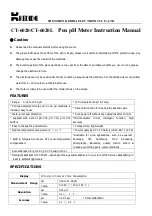
SeaAir Regulator
6
SeaAir Regulator Service and Repair Manual
Preliminary Inspection
External Inspection
1. Closely examine the conical filter to check for any signs that
contaminants have entered the system, including sea water, rust,
or aluminum oxide.
NOTE
: A green discoloration of the filter indicates that
moisture has entered the regulator, and internal corrosion has
possibly occurred. Other types of discoloration may indicate
that the regulator has been used with a corroded cylinder.
Advise the customer of this, and the possible need to obtain
service for the cylinder.
2. Slide back the hose protectors, if present, to visually inspect the
condition of the hoses, especially at their fittings.
3. Closely examine the finish of the first stage to check for any
chips, scratches, or other damage that exposes the brass beneath
the finish.
CAUTION
: Do not clean any parts that show damage to their
finish inside an ultrasonic cleaner.
4. Closely examine all parts of the first stage for any other signs of
external corrosion.
Immersion / Leak Test
1. Check to ensure that the regulator is fully assembled and con-
nected to a second stage, and that there are no open ports or
hoses. Connect the first stage to a cylinder that is filled with
3,000 psi, and open the cylinder valve to pressurize the regula-
tor.
2. If leakage cannot be heard, or if the source of leakage detected
audibly is not obvious, immerse the first stage in fresh water to
check further for any signs of air leakage, especially at the fit-
tings of hoses.
3. Note the source of any leakage found and refer to
the Troubleshooting Guide to determine its possible cause.
4. Close the cylinder valve and depress the second stage purge
button to depressurize the regulator before performing the next
procedure.
Intermediate Pressure Test
2
SECTI
O
N
Summary of Contents for SEAAIR
Page 1: ...Service Repair Manual SERVICE AND REPAIR MANUAL SEAAIR REGULATOR PN RG200 Revised 02 11...
Page 30: ......
Page 31: ......







































